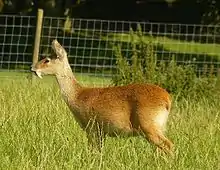List of cervids
Cervidae is a family of hoofed ruminant mammals in the order Artiodactyla. A member of this family is called a deer or a cervid. They are widespread throughout North and South America, Europe, and Asia, and are found in a wide variety of biomes. Most species do not have population estimates, though several are considered endangered or critically endangered, one, Père David's deer, is extinct in the wild, and one, Schomburgk's deer, went extinct in the 20th century.

The 51 species of Cervidae are split into 21 genera within 3 subfamilies: Capreolinae, or New World deer; Cervinae, or Old World deer; and Hydropotinae, comprising the water deer. Extinct species have also been placed into Capreolinae and Cervinae, as well as the extinct subfamily Procervulinae. Over one hundred extinct Cervidae species have been discovered, though due to ongoing research and discoveries the exact number and categorization is not fixed.
Conventions
| IUCN Red List categories | |
|---|---|
| Conservation status | |
| EX | Extinct (1 species) |
| EW | Extinct in the wild (1 species) |
| CR | Critically endangered (2 species) |
| EN | Endangered (5 species) |
| VU | Vulnerable (16 species) |
| NT | Near threatened (4 species) |
| LC | Least concern (12 species) |
| Other categories | |
| DD | Data deficient (9 species) |
| NE | Not evaluated (1 species) |
Conservation status codes listed follow the International Union for Conservation of Nature (IUCN) Red List of Threatened Species. Range maps are provided wherever possible; if a range map is not available, a description of the cervid's range is provided. Ranges are based on the IUCN red list for that species unless otherwise noted. All extinct species or subspecies listed alongside extant species went extinct after 1500 CE, and are indicated by a dagger symbol "![]() ".
".
Classification
The family Cervidae consists of 51 extant species belonging to 21 genera in 3 subfamilies and divided into dozens of extant subspecies. This does not include hybrid species or extinct prehistoric species. Additionally, one species, Schomburgk's deer, went extinct in the 20th century.
- Subfamily Capreolinae (New World deer)
- Genus Alces: one species
- Genus Blastocerus: one species
- Genus Capreolus: two species
- Genus Hippocamelus: two species
- Genus Mazama: nine species
- Genus Odocoileus: two species
- Genus Ozotoceros: one species
- Genus Pudu: two species
- Genus Rangifer: one species
- Subfamily Cervinae (Old World deer)
- Subfamily Hydropotinae
- Genus Hydropotes: one species
Cervids
The following classification is based on the taxonomy described by Mammal Species of the World (2005), with augmentation by generally accepted proposals made since using molecular phylogenetic analysis. This includes merging the two moose species of Alcus into one and splitting out the genus Hyelaphus from Axis. There are several additional proposals which are disputed, such as splitting out the monotypic Panolia genus from Rucervus, combining the monotypic subfamily Hydropotinae with Capreolinae, combining the montypic genus Przewalskium with Cervus, or the addition of the fair brocket to the Mazama genus, which are not included here.[1][2]
Subfamily Capreolinae
| Common name | Scientific name and subspecies | Range | Size and ecology | IUCN status and estimated population |
|---|---|---|---|---|
| Moose
|
A. alces Linnaeus, 1758 Nine subspecies
|
 |
Size: Habitat: Forest and inland wetlands[3] Diet: [3] |
LC
|
| Common name | Scientific name and subspecies | Range | Size and ecology | IUCN status and estimated population |
|---|---|---|---|---|
| Marsh deer
|
B. dichotomus Illiger, 1815 |
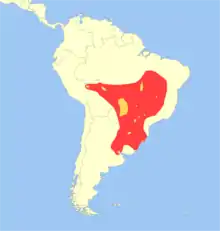 |
Size: Habitat: Savanna, shrubland, and inland wetlands[4] Diet: [4] |
VU
|
| Common name | Scientific name and subspecies | Range | Size and ecology | IUCN status and estimated population |
|---|---|---|---|---|
| Roe deer
|
C. capreolus Linnaeus, 1758 Four subspecies
|
 |
Size: Habitat: Forest, shrubland, grassland, and inland wetlands[5] Diet: [5] |
LC
|
| Siberian roe deer
|
C. pygargus Pallas, 1771 Four subspecies
|
 |
Size: Habitat: Forest, shrubland, grassland, and inland wetlands[6] Diet: [6] |
LC
|
| Common name | Scientific name and subspecies | Range | Size and ecology | IUCN status and estimated population |
|---|---|---|---|---|
| Taruca
|
H. antisensis d'Orbigny, 1834 |
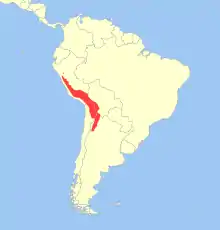 |
Size: Habitat: Shrubland, grassland, rocky areas (eg. inland cliffs, mountain peaks), and other[7] Diet: [7] |
VU
|
| South Andean deer
|
H. bisulcus Molina, 1782 |
 |
Size: Habitat: Forest, shrubland, grassland, inland wetlands, rocky areas (eg. inland cliffs, mountain peaks), and desert[8] Diet: [8] |
EN
|
| Common name | Scientific name and subspecies | Range | Size and ecology | IUCN status and estimated population |
|---|---|---|---|---|
| Red brocket
|
M. americana Erxleben, 1777 Twelve subspecies
|
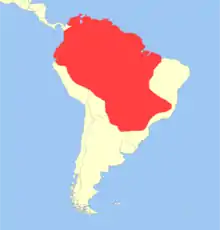 |
Size: Habitat: Forest[9] Diet: [9] |
DD
|
| Small red brocket
|
M. bororo Duarte, 1996 |
 |
Size: Habitat: Forest[10] Diet: [10] |
VU
|
| Mérida brocket | M. bricenii Thomas, 1908 |
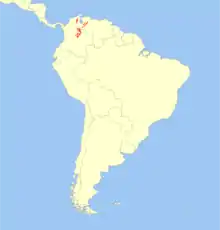 |
Size: Habitat: Forest, shrubland, grassland, rocky areas (eg. inland cliffs, and mountain peaks)[11] Diet: [11] |
VU
|
| Dwarf brocket | M. chunyi Hershkovitz, 1959 |
 |
Size: Habitat: Forest, shrubland, and grassland[12] Diet: [12] |
VU
|
| Gray brocket
|
M. gouazoubira Fischer von Waldheim, 1814 Eleven subspecies
|
 |
Size: Habitat: Forest, savanna, shrubland, and inland wetlands[13] Diet: [13] |
LC
|
| Pygmy brocket
|
M. nana Hensel, 1872 |
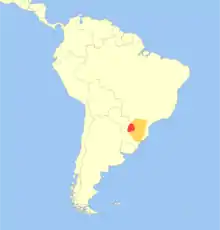 |
Size: Habitat: Forest[14] Diet: [14] |
VU
|
| Yucatan brown brocket
|
M. pandora Merriam, 1901 |
 |
Size: Habitat: Forest, shrubland, and grassland[15] Diet: [15] |
VU
|
| Little red brocket
|
M. rufina Bourcier, Pucheran, 1852 |
 |
Size: Habitat: Forest, shrubland, and grassland[16] Diet: [16] |
VU
|
| Central American red brocket
|
M. temama Kerr, 1792 Three subspecies
|
 |
Size: Habitat: Forest, shrubland, grassland, and inland wetlands[17] Diet: [17] |
DD
|
| Common name | Scientific name and subspecies | Range | Size and ecology | IUCN status and estimated population |
|---|---|---|---|---|
| Mule deer
|
O. hemionus Rafinesque, 1817 Ten subspecies
|
 |
Size: Habitat: Forest, savanna, shrubland, grassland, inland wetlands, desert, and intertidal marine[18] Diet: [18] |
LC
|
| White-tailed deer
|
O. virginianus Rafinesque, 1832 38 subspecies
|
 |
Size: 150–200 cm (59–79 in) long, plus 10–28 cm (4–11 in) tail[19] Habitat: Forest, savanna, shrubland, grassland, inland wetlands, desert, neritic marine, intertidal marine, and coastal marine[20] Diet: [20] |
LC
|
| Common name | Scientific name and subspecies | Range | Size and ecology | IUCN status and estimated population |
|---|---|---|---|---|
| Pampas deer
|
O. bezoarticus Linnaeus, 1758 Five subspecies
|
 |
Size: Habitat: Savanna, grassland, and inland wetlands[21] Diet: [21] |
NT
|
| Common name | Scientific name and subspecies | Range | Size and ecology | IUCN status and estimated population |
|---|---|---|---|---|
| Northern pudú
|
P. mephistophiles Winton, 1896 |
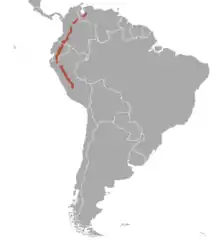 |
Size: Habitat: Forest, shrubland, and grassland[22] Diet: [22] |
DD
|
| Southern pudú
|
P. puda Molina, 1782 |
 |
Size: Habitat: Forest and shrubland[23] Diet: [23] |
NT
|
| Common name | Scientific name and subspecies | Range | Size and ecology | IUCN status and estimated population |
|---|---|---|---|---|
| Reindeer
|
R. tarandus Linnaeus, 1758 Fourteen subspecies
|
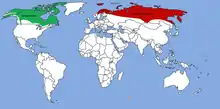 |
Size: Habitat: Forest and grassland[24] Diet: [24] |
VU
|
Subfamily Cervinae
| Common name | Scientific name and subspecies | Range | Size and ecology | IUCN status and estimated population |
|---|---|---|---|---|
| Chital
|
A. axis Erxleben, 1777 |
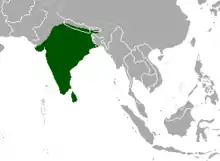 |
Size: Habitat: Forest, savanna, and grassland[25] Diet: [25] |
LC
|
| Common name | Scientific name and subspecies | Range | Size and ecology | IUCN status and estimated population |
|---|---|---|---|---|
| Red deer
|
C. elaphus Linnaeus, 1758 Eighteen subspecies
|
_reconstructed_and_recent.png.webp) |
Size: Habitat: Forest, shrubland, grassland, rocky areas (eg. inland cliffs, and mountain peaks)[26] Diet: [26] |
LC
|
| Sika deer
|
C. nippon Temminck, 1838 Sixteen subspecies
|
East Asia | Size: Habitat: Forest, shrubland, and grassland[27] Diet: [27] |
LC
|
| Common name | Scientific name and subspecies | Range | Size and ecology | IUCN status and estimated population |
|---|---|---|---|---|
| Fallow deer
|
D. dama Linnaeus, 1758 Two subspecies
|
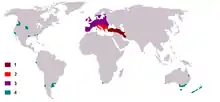 |
Size: 1.3–1.75 cm (1–1 in) long, plus 15–23 cm (6–9 in) tail[28] Habitat: Forest, shrubland, and grassland[29] Diet: [29] |
LC
|
| Common name | Scientific name and subspecies | Range | Size and ecology | IUCN status and estimated population |
|---|---|---|---|---|
| Tufted deer
|
E. cephalophus H. Milne-Edwards, 1872 Four subspecies
|
Central China and northeastern Myanmar | Size: Habitat: Forest and shrubland[30] Diet: [30] |
NT
|
| Common name | Scientific name and subspecies | Range | Size and ecology | IUCN status and estimated population |
|---|---|---|---|---|
| Père David's deer
|
E. davidianus Milne-Edwards, 1866 |
China | Size: Habitat: Grassland, inland wetlands, and intertidal marine[31] Diet: [31] |
EW
|
| Common name | Scientific name and subspecies | Range | Size and ecology | IUCN status and estimated population |
|---|---|---|---|---|
| Indochinese hog deer
|
H. annamiticus Heude, 1888 |
Southeast Asia | Size: Habitat: Diet: |
NE
|
| Calamian deer
|
H. calamianensis Heude, 1888 |
Calamian Islands of the Philippines | Size: Habitat: Forest, savanna, and grassland[32] Diet: [32] |
EN
|
| Bawean deer
|
H. kuhlii Müller, 1840 |
 |
Size: Habitat: Forest and grassland[33] Diet: [33] |
CR
|
| Indian hog deer
|
H. porcinus Zimmermann, 1780 Two subspecies
|
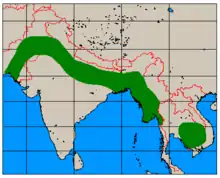 |
Size: Habitat: Savanna, shrubland, grassland, and inland wetlands[34] Diet: [34] |
EN
|
| Common name | Scientific name and subspecies | Range | Size and ecology | IUCN status and estimated population |
|---|---|---|---|---|
| Bornean yellow muntjac | M. atherodes Groves, Grubb, 1982 |
Size: Habitat: Forest[35] Diet: [35] |
NT
| |
| Hairy-fronted muntjac
|
M. crinifrons P. L. Sclater, 1885 |
Size: Habitat: Forest and shrubland[36] Diet: [36] |
VU
| |
| Fea's muntjac
|
M. feae Thomas, Doria, 1889 |
 |
Size: Habitat: Forest[37] Diet: [37] |
DD
|
| Gongshan muntjac | M. gongshanensis , |
 |
Size: Habitat: Forest[38] Diet: [38] |
DD
|
| Indian muntjac
|
M. muntjak Zimmermann, 1780 Eleven subspecies
|
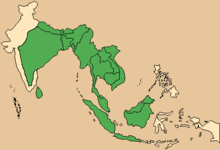 |
Size: Habitat: Forest[39] Diet: [39] |
LC
|
| Pu Hoat muntjac | M. puhoatensis , |
Size: Habitat: Forest[40] Diet: [40] |
DD
| |
| Leaf muntjac | M. putaoensis , |
Size: Habitat: Forest[41] Diet: [41] |
DD
| |
| Reeves's muntjac
|
M. reevesi Ogilby, 1839 Three subspecies
|
Size: Habitat: Forest, shrubland, and grassland[42] Diet: [42] |
LC
| |
| Roosevelt's muntjac | M. rooseveltorum Osgood, 1932 |
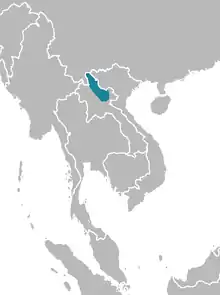 |
Size: Habitat: Forest[43] Diet: [43] |
DD
|
| Truong Son muntjac | M. truongsonensis , |
Size: Habitat: Forest[44] Diet: [44] |
DD
| |
| Giant muntjac | M. vuquangensis , |
 |
Size: Habitat: Forest[45] Diet: [45] |
CR
|
| Common name | Scientific name and subspecies | Range | Size and ecology | IUCN status and estimated population |
|---|---|---|---|---|
| Thorold's deer
|
P. albirostris Przhevalsky, 1883 |
Size: Habitat: Forest, shrubland, and grassland[46] Diet: [46] |
VU
|
| Common name | Scientific name and subspecies | Range | Size and ecology | IUCN status and estimated population |
|---|---|---|---|---|
| Barasingha
|
R. duvaucelii Cuvier, 1823 Three subspecies
|
 |
Size: Habitat: Forest, savanna, grassland, and inland wetlands[47] Diet: [47] |
VU
|
| Eld's deer
|
R. eldii McClelland, 1842 Three subspecies
|
Size: Habitat: Forest, savanna, shrubland, grassland, and inland wetlands[48] Diet: [48] |
EN
| |
| Schomburgk's deer
|
R. schomburgki Blyth, 1863 |
Size: Habitat: Grassland and inland wetlands[49] Diet: [49] |
EX
|
| Common name | Scientific name and subspecies | Range | Size and ecology | IUCN status and estimated population |
|---|---|---|---|---|
| Visayan spotted deer
|
R. alfredi P. L. Sclater, 1870 |
Size: Habitat: Forest, shrubland, and grassland[50] Diet: [50] |
EN
| |
| Philippine deer
|
R. marianna Desmarest, 1822 Four subspecies
|
Size: Habitat: Forest and grassland[51] Diet: [51] |
VU
| |
| Javan rusa
|
R. timorensis Blainville, 1822 Seven subspecies
|
 |
Size: Habitat: Forest, savanna, and grassland[52] Diet: [52] |
VU
|
| Sambar deer
|
R. unicolor Kerr, 1792 Seven subspecies
|
 |
Size: Habitat: Forest, savanna, shrubland, grassland, and inland wetlands[53] Diet: [53] |
VU
|
Subfamily Hydropotinae
| Common name | Scientific name and subspecies | Range | Size and ecology | IUCN status and estimated population |
|---|---|---|---|---|
| Water deer
|
H. inermis Swinhoe, 1870 Two subspecies
|
Size: Habitat: Forest, shrubland, grassland, inland wetlands, and intertidal marine[54] Diet: [54] |
VU
|
Prehistoric cervids
In addition to extant deer, a number of prehistoric species have been discovered and classified as a part of Cervidae. In addition to being placed within the extant subfamilies Capreolinae and Cervinae, they have been categorized within the extinct subfamily Procervulinae.
- Subfamily Capreolinae (New World or telemetecarpal deer)
- Tribe Capreolini
- Genus Bretzia[55]
- B. pseudalces
- B. nebrascensis
- Genus Capreolus
- C. constantini
- C. suessenbornensis
- Genus Cervalces (?= Alces)
- Genus Libralces (?=Cervalces or Alces)
- L. gallicus
- L. reynoldsi
- Genus Procapreolus[56]
- P. cusanus
- P. moldavicus
- P. stenos
- P. ucrainicus
- Genus Pseudalces[57]
- P. mirandus
- P. wenzensis
- Genus Bretzia[55]
- Tribe Rangiferini
- Genus Agalmaceros
- Genus Antifer
- A. ultra
- A. crassus
- Genus Blastocerus
- B. extraneus
- B. arpeitianus
- Genus Charitoceros[58]
- Genus Eocoileus[59]
- E. gentryorum
- Genus Epieuryceros[60]
- E. proximus
- E. truncus
- Genus Morenelaphus
- M. lujanensis
- M. brachyceros
- M. fragilis
- Genus Odocoileus
- O. brachyodontus
- O. dolichopsis
- O. laevicornis
- O. sellardsiae
- O. lucasi
- Genus Torontoceros
- T. hypocaeus
- Tribe Capreolini
- Subfamily Cervinae (Old World deer)
- Tribe Muntiacini (Muntjacs)
- Genus Dicrocerus
- D. elegans
- D. furcatus
- D. necatus
- D. teres
- D. trilateralis
- Genus Euprox[61]
- E. robustus
- E. furcatus
- Genus Eustyloceros[62]
- E. blainvillei
- E. hezhengensis
- E. longchuanensis
- E. maci
- E. pidoplitschkoi
- E. propria
- Genus Muntiacus
- M. leilaoensis
- M. pliocaenicus
- M. polonicus
- Genus Paracervulus[63]
- Genus Stephanocemas[64]
- S. actauensis
- S. aralensis
- S. chinghaiensis
- S. palmatus
- S. rucha
- S. thomsoni
- Genus Dicrocerus
- Tribe Cervini ("true" deer)
- Genus Arvernoceros[65]
- A. giuli
- Genus Axis
- A. nesti
- A. eurygonos
- Genus Candiacervus (sometimes considered a subgenus as Megaloceros or synonym of Praemegaceros; Possibly polyphyletic)
- C. rethymnensis
- C. major
- C. dorothensis
- C. ropalophorus
- C. cretensis
- Genus Cervavitus (?subgenus as Megaloceros)
- Genus Cervus
- C. ertborni
- C. falconeri
- C. giganteus
- C. rhenanus
- C. lascrucensis
- Genus Croizetoceros[66]
- C. ramosus
- Genus Dama[67]
- D. dolichopsis
- D. ensifer
- D. laevicornis
- D. virginiana
- D. whitneyi
- Genus Elaphurus
- E. formosanus
- E. meziesianus
- E. bifurcatus
- E. shikamai
- Genus Eucladoceros
- Eucladoceros tetraceros
- Genus Megaloceros
- M. antecedens
- M. giganteus
- Genus Neomegaloceros[68]
- Genus Nesoleipoceros
- Genus Orchonoceros (sometimes considered a subgenus as Megaloceros)
- Genus Pliocervus[69]
- Genus Praemegaceros (sometimes considered a subgenus as Megaloceros)
- P. obscurus
- P. dawkinsi
- P. savini
- P. verticornis
- P. cazioti
- Genus Praesinomegaceros (sometimes considered a subgenus as Megaloceros)
- P. venustus
- P. asiaticus
- Genus Pseudodama[70]
- Genus Sinomegaceros (sometimes considered a subgenus as Megaloceros)
- S. luochuanensis
- S. pachyosteus
- Genus Arvernoceros[65]
- Tribe Muntiacini (Muntjacs)
- Subfamily Procervulinae (Miocene)[71]
- Genus Procervulus
- P. dichotoma
- Genus Procervulus
See also
References
- Randi, E.; Mucci, N.; Pierpaoli, M.; Douzery, E. (1998). "New phylogenetic perspectives on the Cervidae (Artiodactyla) are provided by the mitochondrial cytochrome b gene". Proceedings of the Royal Society B: Biological Sciences. 265 (1398): 793–801. doi:10.1098/rspb.1998.0362. PMC 1689037. PMID 9628037.
- Marc G.M. van Roosmalen (2015). "Hotspot of new megafauna found in the Central Amazon: the lower Rio Aripuanã Basin" (PDF). Biodiversity Journal. 6 (1): 219–244.
- Hundertmark, K. (2016). "Alces alces". IUCN Red List of Threatened Species. 2016: e.T56003281A22157381. doi:10.2305/IUCN.UK.2016-1.RLTS.T56003281A22157381.en.
- Duarte, J. M. B; Varela, D.; Piovezan, U.; Beccaceci, M. D.; Garcia, J. E. (2016). "Blastocerus dichotomus". IUCN Red List of Threatened Species. 2016: e.T2828A22160916. doi:10.2305/IUCN.UK.2016-1.RLTS.T2828A22160916.en.
- Lovari, S.; Herrero, J.; Masseti, M.; Ambarli, H.; Lorenzini, R.; Giannatos, G. (2016). "Capreolus capreolus". IUCN Red List of Threatened Species. 2016: e.T42395A22161386. doi:10.2305/IUCN.UK.2016-1.RLTS.T42395A22161386.en.
- Lovari, S.; Masseti, M.; Lorenzini, R. (2016). "Capreolus pygargus". IUCN Red List of Threatened Species. 2016: e.T42396A22161884. doi:10.2305/IUCN.UK.2016-1.RLTS.T42396A22161884.en.
- Barrio, J.; Nuñez, A.; Pacheco, L.; Regidor, H. A.; Fuentes-Allende, N. (2017). "Hippocamelus antisensis". IUCN Red List of Threatened Species. 2017: e.T10053A22158621. doi:10.2305/IUCN.UK.2017-2.RLTS.T10053A22158621.en.
- Black-Decima, P. A.; Corti, P.; Díaz, N.; Fernandez, R.; Geist, V.; Gill, R.; Gizejewski, Z.; Jiménez, J.; Pastore, H.; Saucedo, C.; Wittmer, H. (2016). "Hippocamelus bisulcus". IUCN Red List of Threatened Species. 2016: e.T10054A22158895. doi:10.2305/IUCN.UK.2016-1.RLTS.T10054A22158895.en.
- Duarte, J. M. B; Vogliotti, A. (2016). "Mazama americana". IUCN Red List of Threatened Species. 2016: e.T29619A22154827. doi:10.2305/IUCN.UK.2016-1.RLTS.T29619A22154827.en.
- Vogliotti, A.; Oliveira, M. L.; Duarte, J. M. B. (2016). "Mazama bororo". IUCN Red List of Threatened Species. 2016: e.T41023A22155086. doi:10.2305/IUCN.UK.2016-1.RLTS.T41023A22155086.en.
- Lizcano, D. J.; Alvarez, S. J. (2016). "Mazama bricenii". IUCN Red List of Threatened Species. 2016: e.T136301A22165039. doi:10.2305/IUCN.UK.2016-2.RLTS.T136301A22165039.en.
- Rumiz, D. I.; Barrio, J. (2016). "Mazama chunyi". IUCN Red List of Threatened Species. 2016: e.T12913A22165860. doi:10.2305/IUCN.UK.2016-2.RLTS.T12913A22165860.en.
- Black-Decima, P. A.; Vogliotti, A. (2016). "Mazama gouazoubira". IUCN Red List of Threatened Species. 2016: e.T29620A22154584. doi:10.2305/IUCN.UK.2016-2.RLTS.T29620A22154584.en.
- Duarte, J. M. B; Vogliotti, A.; Cartes, J. L.; Oliveira, M. L. (2015). "Mazama nana". IUCN Red List of Threatened Species. 2015: e.T29621A22154379. doi:10.2305/IUCN.UK.2015-4.RLTS.T29621A22154379.en.
- Weber, M.; de Grammont, P. C.; Cuarón, A. D. (2016). "Mazama pandora". IUCN Red List of Threatened Species. 2016: e.T29622A22154219. doi:10.2305/IUCN.UK.2016-2.RLTS.T29622A22154219.en.
- Lizcano, D. and Alvarez; S. J. (2016). "Mazama rufina". IUCN Red List of Threatened Species. 2016: e.T12914A22165586. doi:10.2305/IUCN.UK.2016-2.RLTS.T12914A22165586.en.
- Bello, J.; Reyna, R.; Schipper, J. (2016). "Mazama temama". IUCN Red List of Threatened Species. 2016: e.T136290A22164644. doi:10.2305/IUCN.UK.2016-2.RLTS.T136290A22164644.en.
- Sanchez Rojas, G. and Gallina Tessaro; S. (2016). "Odocoileus hemionus". IUCN Red List of Threatened Species. 2016: e.T42393A22162113. doi:10.2305/IUCN.UK.2016-1.RLTS.T42393A22162113.en.
- Dewey, Tanya (2003). "Odocoileus virginianus". Animal Diversity Web. University of Michigan. Retrieved November 28, 2020.
- Gallina, S. and Lopez Arevalo; H. (2016). "Odocoileus virginianus". IUCN Red List of Threatened Species. 2016: e.T42394A22162580. doi:10.2305/IUCN.UK.2016-2.RLTS.T42394A22162580.en.
- González, S.; Jackson, III; J. J., Merino; M. L. (2016). "Ozotoceros bezoarticus". IUCN Red List of Threatened Species. 2016: e.T15803A22160030. doi:10.2305/IUCN.UK.2016-1.RLTS.T15803A22160030.en.
- Barrio, J.; Tirira, D. G. (2019). "Pudu mephistophiles". IUCN Red List of Threatened Species. 2019: e.T18847A22163836. doi:10.2305/IUCN.UK.2019-1.RLTS.T18847A22163836.en.
- Silva-Rodríguez, E; Pastore, H.; Jiménez, J. (2016). "Pudu puda". IUCN Red List of Threatened Species. 2016: e.T18848A22164089. doi:10.2305/IUCN.UK.2016-1.RLTS.T18848A22164089.en.
- Gunn, A. (2016). "Rangifer tarandus". IUCN Red List of Threatened Species. 2016: e.T29742A22167140. doi:10.2305/IUCN.UK.2016-1.RLTS.T29742A22167140.en.
- Duckworth, J. W.; Kumar, N. S.; Anwarul Islam, M.; Sagar Baral, H.; Timmins, R. (2015). "Axis axis". IUCN Red List of Threatened Species. 2015: e.T41783A22158006. doi:10.2305/IUCN.UK.2015-4.RLTS.T41783A22158006.en.
- Lovari, S.; Lorenzini, R.; Masseti, M.; Pereladova, O.; Carden, R. F.; Brook, S. M.; Mattioli, S. (2018). "Cervus elaphus (errata version published in 2019)". IUCN Red List of Threatened Species. 2018: e.T55997072A142404453. doi:10.2305/IUCN.UK.2018-2.RLTS.T55997072A142404453.en.
- Harris, R. B. (2015). "Cervus nippon". IUCN Red List of Threatened Species. 2015: e.T41788A22155877. doi:10.2305/IUCN.UK.2015-2.RLTS.T41788A22155877.en.
- Dharmani, Aarti (2000). "Dama dama". Animal Diversity Web. University of Michigan. Retrieved November 28, 2020.
- Masseti, M.; Mertzanidou, D. (2008). "Dama dama". IUCN Red List of Threatened Species. 2008: e.T42188A10656554. doi:10.2305/IUCN.UK.2008.RLTS.T42188A10656554.en.
- Harris, R. B.; Jiang, Z. (2015). "Elaphodus cephalophus". IUCN Red List of Threatened Species. 2015: e.T7112A22159620. doi:10.2305/IUCN.UK.2015-2.RLTS.T7112A22159620.en.
- Jiang, Z.; Harris, R. B. (2016). "Elaphurus davidianus". IUCN Red List of Threatened Species. 2016: e.T7121A22159785. doi:10.2305/IUCN.UK.2016-2.RLTS.T7121A22159785.en.
- Widmann, P.; Lastica, E. (2015). "Axis calamianensis". IUCN Red List of Threatened Species. 2015: e.T2446A22156678. doi:10.2305/IUCN.UK.2015-2.RLTS.T2446A22156678.en.
- Semiadi, G.; Duckworth, J. W.; Timmins, R. (2015). "Axis kuhlii". IUCN Red List of Threatened Species. 2015: e.T2447A73071875. doi:10.2305/IUCN.UK.2015-2.RLTS.T2447A73071875.en.
- Timmins, R.; Duckworth, J. W.; Samba Kumar, N.; Anwarul Islam, M.; Sagar Baral, H.; Long, B.; Maxwell, A. (2015). "Axis porcinus". IUCN Red List of Threatened Species. 2015: e.T41784A22157664. doi:10.2305/IUCN.UK.2015-4.RLTS.T41784A22157664.en.
- Timmins, R. J.; Belden, G.; Brodie, J.; Ross, J.; Wilting, A.; Duckworth, J. W. (2016). "Muntiacus atherodes". IUCN Red List of Threatened Species. 2016: e.T42189A22166396. doi:10.2305/IUCN.UK.2016-2.RLTS.T42189A22166396.en.
- Timmins, R.; Chan, B. (2016). "Muntiacus crinifrons". IUCN Red List of Threatened Species. 2016: e.T13924A22160753. doi:10.2305/IUCN.UK.2016-1.RLTS.T13924A22160753.en.
- Timmins, R.; Steinmetz, R.; Chutipong, W. (2016). "Muntiacus feae". IUCN Red List of Threatened Species. 2016: e.T13927A22160266. doi:10.2305/IUCN.UK.2016-1.RLTS.T13927A22160266.en.
- Timmins, R.; Duckworth, J. W. (2016). "Muntiacus gongshanensis". IUCN Red List of Threatened Species. 2016: e.T13926A22160596. doi:10.2305/IUCN.UK.2016-1.RLTS.T13926A22160596.en.
- Timmins, R. J.; Duckworth, J. W.; Hedges, S. (2016). "Muntiacus muntjak". IUCN Red List of Threatened Species. 2016: e.T42190A56005589. doi:10.2305/IUCN.UK.2016-1.RLTS.T42190A56005589.en.
- Timmins, J; Duckworth, J. W. (2016). "Muntiacus puhoatensis". IUCN Red List of Threatened Species. 2016: e.T136293A22164930. doi:10.2305/IUCN.UK.2016-1.RLTS.T136293A22164930.en.
- Timmins, R. J.; Duckworth, J. W. (2016). "Muntiacus putaoensis". IUCN Red List of Threatened Species. 2016: e.T136479A22159478. doi:10.2305/IUCN.UK.2016-1.RLTS.T136479A22159478.en.
- Timmins, J; Chan, B. (2016). "Muntiacus reevesi (errata version published in 2020)". IUCN Red List of Threatened Species. 2016: e.T42191A170905827. doi:10.2305/IUCN.UK.2016-2.RLTS.T42191A170905827.en.
- Timmins, R.; Duckworth, J. W. (2016). "Muntiacus rooseveltorum". IUCN Red List of Threatened Species. 2016: e.T13928A22160435. doi:10.2305/IUCN.UK.2016-1.RLTS.T13928A22160435.en.
- Timmins, R.; Duckworth, J. W. (2016). "Muntiacus truongsonensis". IUCN Red List of Threatened Species. 2016: e.T44704A22154056. doi:10.2305/IUCN.UK.2016-1.RLTS.T44704A22154056.en.
- Timmins, R. J.; Duckworth, J. W.; Robichaud, W.; Long, B.; Gray, T. N. E.; Tilker, A. (2016). "Muntiacus vuquangensis". IUCN Red List of Threatened Species. 2016: e.T44703A22153828. doi:10.2305/IUCN.UK.2016-2.RLTS.T44703A22153828.en.
- Harris, R. B. (2015). "Cervus albirostris". IUCN Red List of Threatened Species. 2015: e.T4256A61976756. doi:10.2305/IUCN.UK.2015-2.RLTS.T4256A61976756.en.
- Duckworth, J. W.; Kumar, N. S.; Pokharel, C. P.; Sagar Baral, H.; Timmins, R. (2015). "Rucervus duvaucelii". IUCN Red List of Threatened Species. 2015: e.T4257A22167675. doi:10.2305/IUCN.UK.2015-4.RLTS.T4257A22167675.en.
- Gray, T. N. E.; Brook, S. M.; McShea, W. J.; Mahood, S.; Ranjitsingh, M. K.; Miyunt, A.; Hussain, S. A.; Timmins, R. (2015). "Rucervus eldii". IUCN Red List of Threatened Species. 2015: e.T4265A22166803. doi:10.2305/IUCN.UK.2015-2.RLTS.T4265A22166803.en.
- Duckworth, J. W.; Robichaud, W.; Timmins, R. (2015). "Rucervus schomburgki". IUCN Red List of Threatened Species. 2015: e.T4288A79818502. doi:10.2305/IUCN.UK.2015-3.RLTS.T4288A79818502.en.
- Brook, S. M. (2016). "Rusa alfredi". IUCN Red List of Threatened Species. 2016: e.T4273A22168782. doi:10.2305/IUCN.UK.2016-2.RLTS.T4273A22168782.en.
- MacKinnon, J. R.; Ong, P.; Gonzales, J. (2015). "Rusa marianna". IUCN Red List of Threatened Species. 2015: e.T4274A22168586. doi:10.2305/IUCN.UK.2015-2.RLTS.T4274A22168586.en.
- Hedges, S.; Duckworth, J. W.; Timmins, R.; Semiadi, G.; Dryden, G. (2015). "Rusa timorensis". IUCN Red List of Threatened Species. 2015: e.T41789A22156866. doi:10.2305/IUCN.UK.2015-2.RLTS.T41789A22156866.en.
- Timmins, R.; Kawanishi, K.; Giman, B; Lynam, A.; Chan, B.; Steinmetz, R.; Sagar Baral, H.; Samba Kumar, N. (2015). "Rusa unicolor (errata version published in 2015)". IUCN Red List of Threatened Species. 2015: e.T41790A85628124. doi:10.2305/IUCN.UK.2015-2.RLTS.T41790A22156247.en.{{cite iucn}}: error: |doi= / |page= mismatch (help)
- Harris, R. B.; Duckworth, J. W. (2015). "Hydropotes inermis". IUCN Red List of Threatened Species. 2015: e.T10329A22163569. doi:10.2305/IUCN.UK.2015-2.RLTS.T10329A22163569.en.
- Morejohn, G.V.; Hearst, J.; et al. (February 2005). "Postcranial carpalial support for the extinct cervid genus Bretzia with associated antler". Journal of Mammalogy. 86 (1): 115–120. doi:10.1644/1545-1542(2005)086<0115:PCSFTE>2.0.CO;2.
- Valli, A.M.F. (February 2010). "Dispersion of the genus Procapreolus and the relationships between Procapreolus cusanus and the roe deer (Capreolus)". Quaternary International. 212 (2): 80–85. Bibcode:2010QuInt.212...80V. doi:10.1016/j.quaint.2008.11.002.
- Flerov, K.K.; Shevyreva, N.S. (1965). "Pseudalces, Pliocene deer from Ciscaucasus". International Geology Review. 7 (5): 931–934. Bibcode:1965IGRv....7..931F. doi:10.1080/00206816509474162.
- Valli, A.M.F. (March 2018). "Late Pleistocene seer in the region of the National Park "Serra da Capivara" (Piauí, Brazil)". Quaternary. 1 (1): 4. doi:10.3390/quat1010004.
- Webb, S.D.; Hulbert, R.C.; et al. (May 2008). "Terrestrial mammals of the Palmetto Fauna (early Pliocene, latest Hemphillian) from the Central Florida Phosphate District". Science Series, Natural History Museum of Los Angeles County. 41: 293–312. Retrieved 12 August 2020.
- Alcaraz, M.; Zurita, A. (2004). "Nuevos registros de cérvidos poco conocidos: Epieuryceros cf. proximus Castellanos y Antifer sp. (Mammalia, Artiodactyla, Cervidae)". Revista de Museo Argentino de Ciencias Naturales. 6 (1). Retrieved 12 August 2020.
- Dong, W.; Liu, J.; Pan, Y. (2003). "A new Euprox from the Late Miocene of Yuanmou, Yunnan Province, China, with interpretation of its paleoenvironment". Chinese Science Bulletin. 48 (5): 485–91. Bibcode:2003ChSBu..48..485D. doi:10.1007/BF03183257. S2CID 140586480.
- Deng, T. (2014). "A new species of Eostyloceros (Cervidae, Artiodactyla) from the Late Miocene of the Linxia Basin in Gansu, China". Zootaxa. 3893 (3): 363–81. doi:10.11646/zootaxa.3893.3.3. PMID 25544527.
- "Paracervulus". Species. GBIF. Retrieved 14 April 2016.
- Wang, X.; Xie, G.; Dong, W. (2009). "A new species of crown-antlered deer Stephanocemas (Artiodactyla, Cervidae) from the middle Miocene of Qaidam Basin, northern Tibetan Plateau, China, and a preliminary evaluation of its phylogeny". Zoological Journal of the Linnean Society. 156 (3): 680–95. doi:10.1111/j.1096-3642.2008.00491.x.
- Petronio, C.; Pandolfi, L. (2011). "First Occurrence of the Genus Arvernoceros Heintz, 1970 from the Late Early Pleistocene of Italy". Rivista Italiana di Paleontologia e Stratigrafia. 117 (3): 501–8. doi:10.13130/2039-4942/5988.
- Lindsay, E. H.; Fahlbusch, V.; Mein, P., eds. (1989). European Neogene Mammal Chronology. New York, USA: Plenum Press. p. 205. ISBN 978-1-4899-2513-8.
- Bulletin of the United States Geological Survey (Report). United States Geological Survey. 1902. pp. 682–6.
- Vislobokova, I.A. (December 2011). "Historical development and geographical distribution of giant deer (Cervidae, Megacerini)". Paleontological Journal. 45 (6): 674–688. doi:10.1134/S0031030111060153. S2CID 85326341.
- "Pliocervus". Species. GBIF. Retrieved 14 April 2016.
- Mazza, P. P. A. (2006). "Poggio Rosso (Upper Valdarno, central Italy), A window on latest Pliocene wildlife". PALAIOS. 21 (5): 493–8. Bibcode:2006Palai..21..493M. doi:10.2110/palo.2005.P05-033R. S2CID 129513994.
- Gentry, A. W. (1993). "Procervulus Gaudry, 1877 (Mammalia, Artiodactyla): proposed designation of Antilope dichotoma Gervais, 1849 as the type species". The Bulletin of Zoological Nomenclature. 50 (2): 137–9. doi:10.5962/bhl.part.1820.
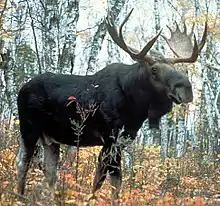
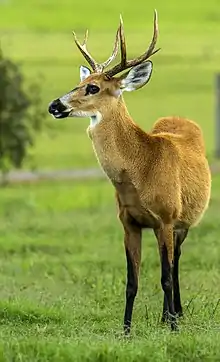




_male_(28091090800).jpg.webp)




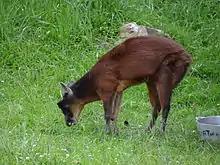

.jpg.webp)


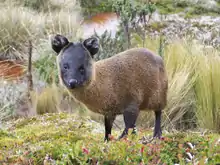




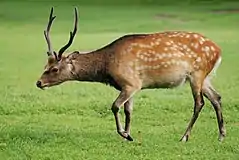
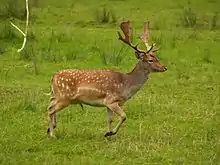

.jpg.webp)
.jpg.webp)


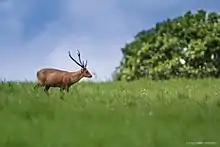

.jpg.webp)


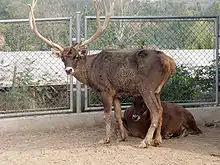
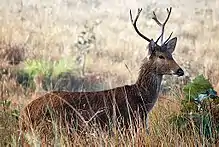
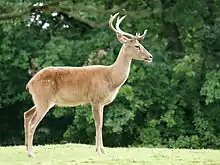

.jpg.webp)
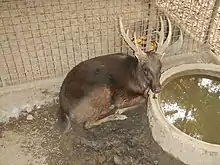
.jpg.webp)
_male.jpg.webp)
